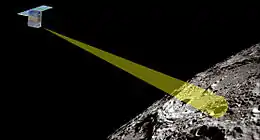SkyFire (spacecraft)
SkyFire is a planned nanosatellite spacecraft that will fly by the Moon and collect surface spectroscopy and thermography. It is planned to fly on the Space Launch System.
 | |
| Names | LunIR |
|---|---|
| Mission type | Technology demo, reconnaissance |
| Operator | Lockheed Martin |
| Spacecraft properties | |
| Spacecraft | SkyFire |
| Spacecraft type | CubeSat |
| Bus | 6U |
| Manufacturer | Lockheed Martin |
| Launch mass | 14 kg (31 lb) |
| Dimensions | 10×20×30 cm |
| Start of mission | |
| Launch date | 2021[2][3] |
| Rocket | SLS Block 1 |
| Launch site | Kennedy LC-39B |
| Flyby of Moon | |
Mission
Its purpose is that of a Geosynchronous Earth Orbit (GEO) technology demonstration using a low-cost 6U CubeSat spacecraft. SkyFire will perform a lunar flyby, collecting spectroscopy and thermography for surface characterization, remote sensing, and site selection.[4] The spacecraft includes two deployable solar arrays and will have a total mass of about 14 kg (31 lb).
SkyFire was selected in April 2015 by NASA's NextSTEP program (Next Space Technologies for Exploration Partnerships) and awarded a contract to Lockheed Martin Space systems worth $1.4 million for further development.[5][6][7]
Launch
SkyFire will fly along other 12 CubeSats as a secondary payload mission on the maiden flight of the Space Launch System.
Propulsion
SkyFire will also demonstrate a low thrust electric propulsion technology called electrospray propulsion to lower the spacecraft's orbit for additional science and technology mission objectives.[8]
See also
- The 13 CubeSats flying in the Artemis 1 mission
- Lunar Flashlight will map exposed water ice on the Moon
- Near-Earth Asteroid Scout by NASA is a solar sail spacecraft that will encounter a near-Earth asteroid
- BioSentinel is an astrobiology mission
- SkyFire by Lockheed Martin
- Lunar IceCube, by the Morehead State University
- CubeSat for Solar Particles (CuSP)
- Lunar Polar Hydrogen Mapper (LunaH-Map), designed by the Arizona State University
- EQUULEUS, submitted by JAXA and the University of Tokyo
- OMOTENASHI, submitted by JAXA, is a lunar lander
- ArgoMoon, designed by Argotec and coordinated by Italian Space Agency
- Cislunar Explorers, Cornell University, Ithaca, New York
- Earth Escape Explorer (CU-E3), University of Colorado Boulder
- Team Miles, by Fluid & Reason, LLC. Florida
References
- https://space.skyrocket.de/doc_sdat/lunir.htm
- "NASA's large SLS rocket unlikely to fly before at least late 2021". 17 July 2019.
- "NASA's large SLS rocket unlikely to fly before at least late 2021". 17 July 2019.
- Williams, Greg; Crusan, Jason (April 2015). "Pioneering Space –the Evolvable Mars Campaign" (PDF). NASA. Retrieved 2015-05-26.
- Morring, Frank (24 April 2015). "Habitats Could Be NASA's Next Commercial Spacecraft Buy". Aviation Week. Retrieved 2015-05-26.
- Clark, Stephen (8 April 2015). "NASA adding to list of CubeSats flying on first SLS mission". Spaceflight Now. Retrieved 2015-05-25.
- Krebs, Gunter Dirk (19 May 2015). "Skyfire". Gunter's Space Page. Retrieved 2015-05-26.
- "Next Space Technologies for Exploration Partnerships (NextSTEP) Projects". NASA. NASA. May 5, 2015. Retrieved 2016-02-05.